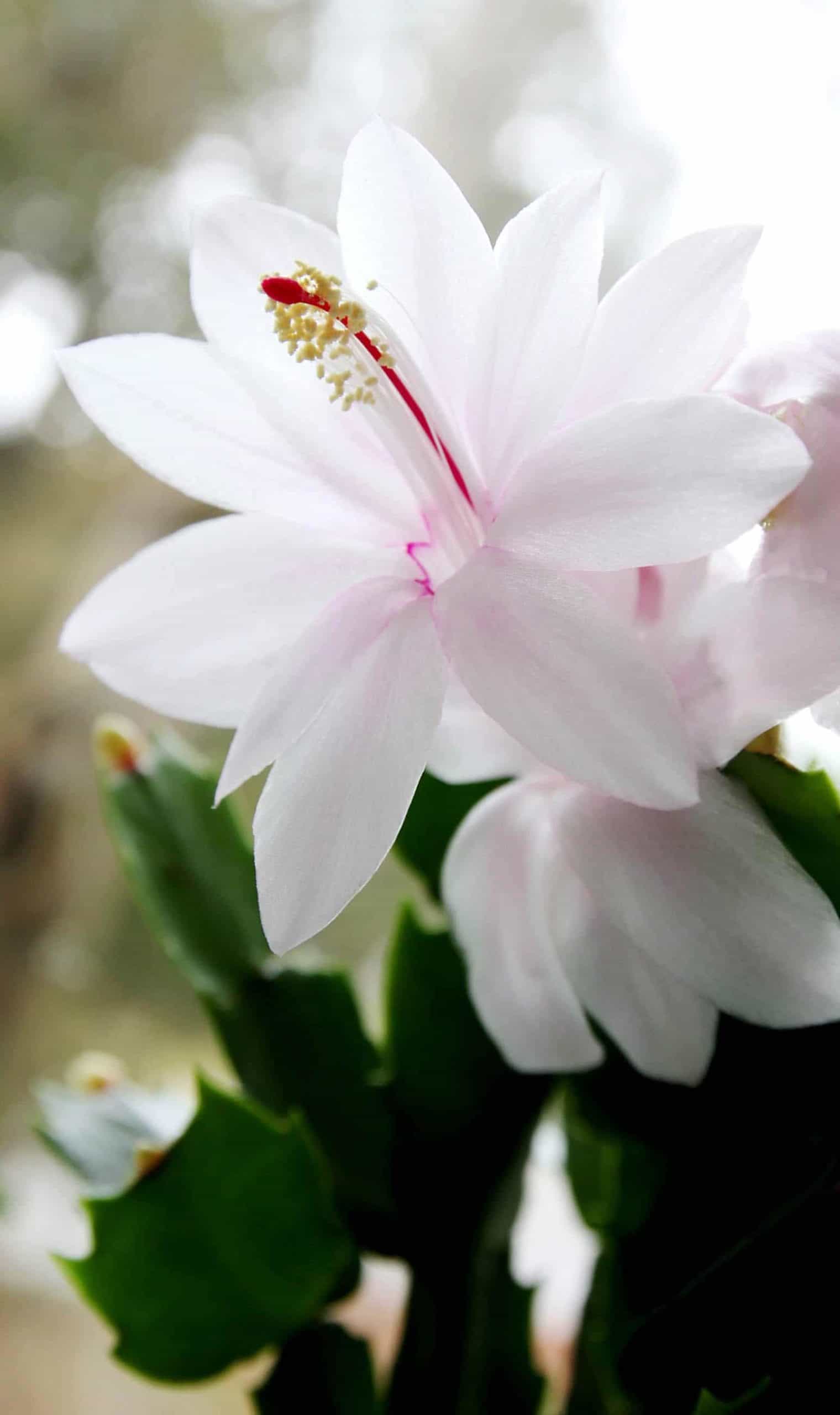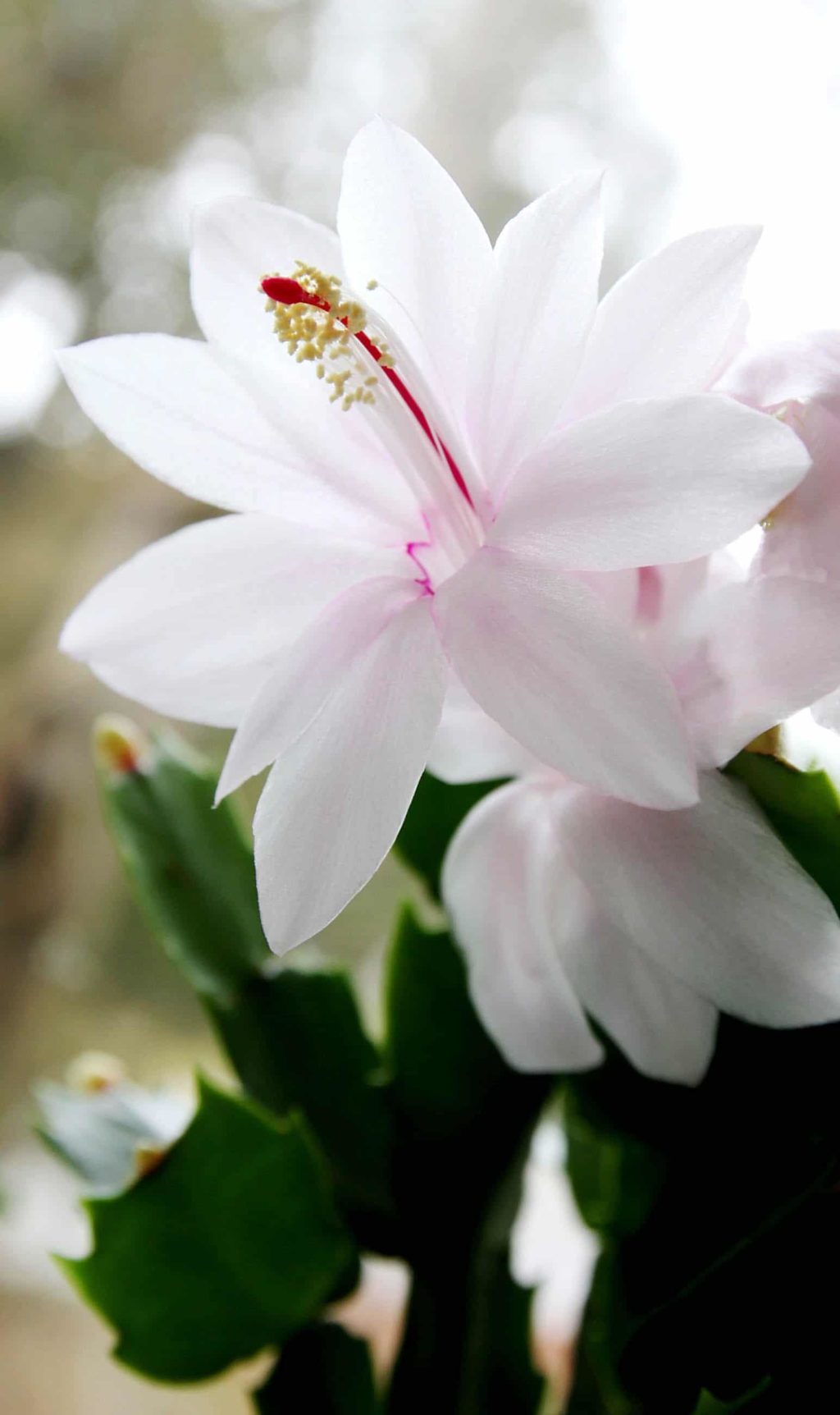
Every year at this time I’m confronted with supermarket displays of Christmas cactus (Schlumbergera x buckleyi), usually heavy with buds, and of course I always buy one. I’ve known gardeners who inherited Christmas cactus from their grandparents, large enough to require a table dedicated to supporting them. This has not been my experience and, in fact, I hold the indoor record for speedy dispatch of this plant to the compost bin.
One year, I purchased a Christmas cactus with ethereal white blossoms with deep raspberry markings. After I brought it home, the flower buds swelled, two of them opened and the rest fell off. I realize it’s asking a lot of an understorey tropical forest cactus from the coastal mountains of southeastern Brazil to adapt to winter living room conditions in Ontario. But it does seem cruel that a potentially gorgeous plant arrives with dozens of flower buds intact and then dumps most of them within 10 days. As you may guess, this was my attempt to displace blame to the plants, to the greenhouse personnel who produced the plants or any circumstance apart from my own treatment. I don’t like it when plants fail on my watch.
Christmas cactus care
Christmas cactus are easy plants to grow, and most problems are related to flowering. They need a slightly dry, cool and dark resting phase in autumn to produce flower buds. Similar to the poinsettia, the forest cactus clan requires 12 hours of complete darkness each day starting in mid-September for about six weeks, with absolutely no artificial light during the night periods. That means putting the plant in a closet for 12 hours every night, and bringing it out into a southeast or northwest window for the daylight hours. During these weeks allow the soil to dry slightly (but not dry out entirely), and the room temperature should be in the cool range around 15°C, and lower (in the closet) at night. When buds are evident along the leaf tips, the plant can remain in the window for display, and watering should be increased. Keep the soil moderately moist (but not wet) and provide forest-like air humidity to retain flower buds.
Greenhouses have all sorts of equipment and personnel to easily maintain these conditions, but domestic houses fall far short of the tropical forest conditions. I don’t know anyone who plans their days and nights around moving the Christmas cactus in and out of a closet. But I do know gardeners who have some success initiating flower buds in unorthodox ways. Some put the plant outdoors in June in a shady location, and don’t bring it back in until the end of October (or sooner if nights threaten to be frosty), providing water and feeding twice with a balanced fertilizer (such as 10-10-10). By then it’s had a summer growing phase and an early autumn cool period, during which watering in September and October is cut back to half the summer amount. Perhaps this is enough to trigger flower buds; it also helps if the plant is somewhat root bound, in a tight pot.
Other gardeners do almost nothing, allowing the cactus to remain in its permanent indoor position the full year. Sometimes a dark paper bag is used to cover the plant for 12 night hours (not complete darkness, but sort of dim). If light isn’t too bright in the room, the plants sometimes produce flower buds on the back, or dark side, positioned away from the window. It’s all a matter of the plant’s ability to accommodate our lax and inattentive care, while striving to propagate its species by producing flowers. Unfortunately, we’ve crossed them up again with hybridization, which produces the lovely supermarket colours at the expense of fertility. What’s a plant to do, but struggle on in a world of commercial plant production?










I live in the Niagara Region of Ontario and have had very good luck with Christmas cactus of which I have 2 in beautiful bloom right now. When spring arrives I move my cactus outdoors in a shady location. And basically ignore it all summer except for water if necessary. I leave them there right through fall until the first frost threatens – by this time mine are full of buds. Bring them indoors to a cool spot by a window and they always hold the buds and bloom – some even have double blooms.
Hi Tina (Jan. 5)
The success of your Christmas cactus is absolutely inspirational! Perhaps it’s time to liberate these beautiful plants from dark closets, and let them show us what they can do, unassisted by fussing gardeners.
— Judith
Hi Judith
I really feel for you. I too am a killer of many an indoor plant, but NOT my Christmas cactus. I’ve had it in the same spot for 5+ years (repotted once already) and it blooms 2 or even 3 waves per fall/winter. And I do absolutely nothing to help it happen. It’s off 2 feet to the right of a large south-facing window, in a room surrounded by further east- and west-facing windows–none with window coverings. I just give it maybe a bit more water than usual when I see the buds, otherwise, it’s mostly ignored. And fabulous!
Hi Ariel (Dec. 29),
You’re very patient! Perhaps the combination of light and companionship is just what your grandmother’s plant needed. You can’t argue with success!
— Judith
Mary (Dec.21),
That must be the answer, don’t give them too much love. It’s interesting that your cactus plants have two periods of bloom. I guess that’s real happiness!
— Judith
Thanks for the info. My cactus bloomed for the first time in 8 years this year. My grandmother used to put it outside under a pine tree all summer and then bring it in but we are in a condo with a west-facing balcony so that’s out. I put it in a north window and paired it with a smaller one that had already bloomed once. Now the big one is set to bloom and the small one is going to bloom again!
I too have several Christmas Cactus plants which now flower twice yearly, (November/December and March/April), one similar to the one shown, and 2 red ones, all have been in the same pot(s) for the past 6 years. I have moved house and still they bloom twice yearly, sometimes if the house is too warm, the blossoms seem to drop early. If it is kept close to the window, where it is relatively cool; in my case the north west light (but well shaded so it is dim), the plants do quite well. I have other plants that have done amazingly well despite my ignoring them so I believe that is the answer, don’t fuss just enjoy them.
Hi Elizabeth,
My goodness, but you have found a perfect method of getting these plants to bloom! This is a good example of providing what the plants need, at the time they need it, and with not too much effort from the gardener. Thanks for the method and schedule information, I’ll definitely be trying to follow this.
— Judith
Hi Jennifer,
And a happy holiday season to you, also! I’ve seen the same thing–tropical plants being carried through a blast of freezing wind on the way to the car, sometimes with no protection at all. If plants could scream…. Anytime I’m in a similar circumstance, having purchased something tropical, I demand two bags (or as many as needed) to adequately keep wind off the plant. We must educate stores that this is necessary if they’re going to sell tropical plants. A thick (or double) wall of paper is sufficient to sprint to the car. A few minutes of chilling does no harm, but the wind passing over tender plant tissues is a killer.
— Judith
I’ve had four Christmas cactus for years. I put them out in their pots in a part of the garden where they get a bit of morning sun and afternoon shade from late May to in late August. I water when the soil is dry to the touch – no fertilizer. In the Fall they go under growlights in the basement which are off from 9:00PM to 8:00AM. By the end of November they are dripping with blossoms. Fall and Winter I water once a week and fertilize from Janury to May. They are seriously pot bound.
Thanks Judy, I never though to treat the Medinilla like the orchids, and maybe they too would like a visit to a post shower, shower stall 🙂
Hi Cris,
Wow, what a gorgeous plant! (I had to look it up.) The Medinilla magnifica has such lovely foliage, it will be beautiful even out of bloom. Because it’s from a tropical forest, you’re right about the need for humidity. I use a room humidifier for my orchids in winter months (whenever the house is heated), and it’s made a big difference. No obvious moisture on furniture surfaces, but the plants do seem to perk up. Reading about the Medinilla, one source mentions it’s irregular in blooming, sometimes skipping a year. To avoid this, you might try using a fertilizer with a higher middle number (phosphorus), to trigger flower bud formation. You can find this formula in an orchid fertilizer product, and that’s fine for encouraging any plant to bloom.
— Judith
Seasons greetings to all at Garden Making magazine.
One thought about the Christmas cactus, which also applies to poinsettias at this time of year. The blast of cold air as the plant travels through the parking lot after purchase has a very bad effect. The single thickness paper sleeves are not very good protection and I cringe when I see the plants being carried out without even that covering.
Thanks for the tip, it might also help if my resident gardener’s helper would water it less. My 10-year-old Christmas cactus lives in the same place and went into full bloom in September, I guess on its own schedule. Next year I will regain control, or so I think.
The garden shed is indeed shut down for the winter but I have acquired the amazing Medinilla magnifica plant and I am confident it will keep me enthralled until the spring thaw and the race to the garden.
What a beauty, I find myself completely in awe. It likes a dry base but a goodly amount of humidity, so after I shower I place it inside the shower enclosure to let it revel in a version of its natural environment. I need to get a life 🙂
Merry Christmas everyone and sweet dreams of spring sprouting.
Hi Allan,
Thanks for telling me about your inherited Christmas cactus, I know there must be lots of these old family plants out there. You certainly have worked out an effective and easy way of getting it to bloom without being a slave to the closet method. Bravo!
— Judith
I also inherited my Christmas Cactus. I estimate it’s about 45 years old. It goes out into the garden every year, and faithfully blooms each Christmas. It’s in my office now with about a dozen blooms, and many more to come. I have never put the plant in closets or covered. I do let it dry out and then full watering in early November.